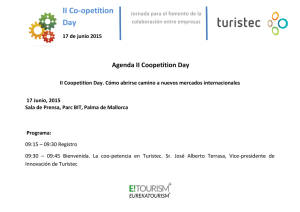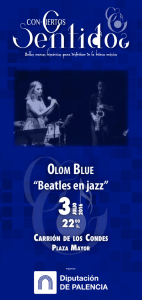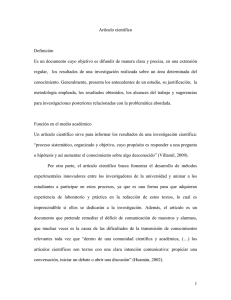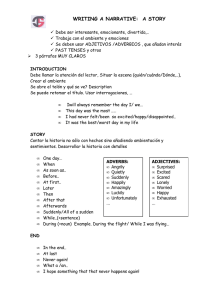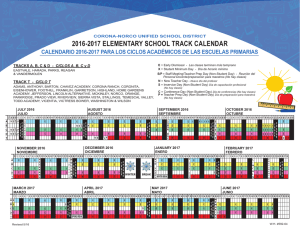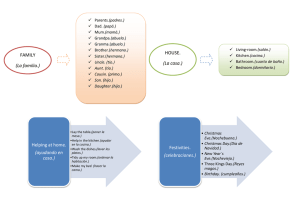Sample Syllabus Jaclyn Cohen Representations of Gender in
Anuncio
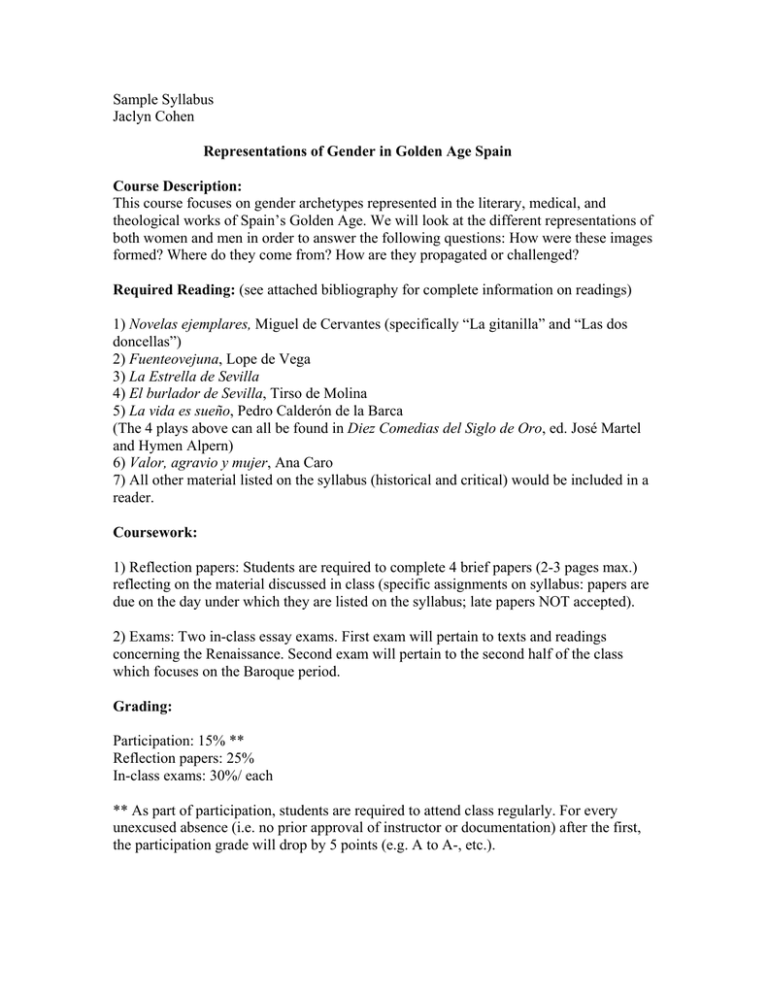
Sample Syllabus Jaclyn Cohen Representations of Gender in Golden Age Spain Course Description: This course focuses on gender archetypes represented in the literary, medical, and theological works of Spain’s Golden Age. We will look at the different representations of both women and men in order to answer the following questions: How were these images formed? Where do they come from? How are they propagated or challenged? Required Reading: (see attached bibliography for complete information on readings) 1) Novelas ejemplares, Miguel de Cervantes (specifically “La gitanilla” and “Las dos doncellas”) 2) Fuenteovejuna, Lope de Vega 3) La Estrella de Sevilla 4) El burlador de Sevilla, Tirso de Molina 5) La vida es sueño, Pedro Calderón de la Barca (The 4 plays above can all be found in Diez Comedias del Siglo de Oro, ed. José Martel and Hymen Alpern) 6) Valor, agravio y mujer, Ana Caro 7) All other material listed on the syllabus (historical and critical) would be included in a reader. Coursework: 1) Reflection papers: Students are required to complete 4 brief papers (2-3 pages max.) reflecting on the material discussed in class (specific assignments on syllabus: papers are due on the day under which they are listed on the syllabus; late papers NOT accepted). 2) Exams: Two in-class essay exams. First exam will pertain to texts and readings concerning the Renaissance. Second exam will pertain to the second half of the class which focuses on the Baroque period. Grading: Participation: 15% ** Reflection papers: 25% In-class exams: 30%/ each ** As part of participation, students are required to attend class regularly. For every unexcused absence (i.e. no prior approval of instructor or documentation) after the first, the participation grade will drop by 5 points (e.g. A to A-, etc.). COURSE CALENDAR Week 1: Introduction to the literature of the Renaissance Day 1: Introduction to course; discussion of the prevalent ideas of the Renaissance (humanism, Platonism, etc…) Day 2: Discussion of select articles from Francisco Rico’s crucial compilation, Historia y crítica de la literatura española. The second section, Siglos de Oro: Renacimiento. Rico’s introduction, “Temas y problemas del renacimiento” and Alexander Parker’s article, pg. 54. Week 2: Gendered Emotions- medical perspectives of gender Day 1: Aristotle, Rhetoric (portion); discussion of emotions and their relations to gender differentiation, specifically the theory of the humors Day 2: Further discussion including Ian Maclean’s The Renaissance Notion of Woman (chapter on medical texts) and the idea of woman as inverted male Week 3: Religious views on gender Day 1: Fray Luis de León, La perfecta casada (portion); the woman as pure and chaste, the man as head of household Day 2: Santa Teresa de Jesús, Libro de la vida (portion); discussion of mysticism and the idea of a woman writing in the convent. Week 4: Cervantes- The strong woman? (portions from Don Quijote) Day 1: A look into the story of Marcela and Grisóstomo (included in reader) Day 2: A discussion of “el capitán cautivo” FIRST PAPER DUE discussing Renaissance themes and medical and religious views of gender. Week 5: Cervantes continued- Novelas ejemplares Day 1: Introduction and story of “La gitanilla”; discussion: the woman as commerce Day 2: Introduction and story of “Las dos doncellas”; discussion: traditional ending of marriage, restoration of honor, cross-dressing women Week 6: Review and exam 1 Day 1: Review of Renaissance themes and literature Day 2: Exam 1 Week 7: Introduction to Baroque themes and literature Day 1: From Rico’s compilation, Siglos de Oro, Barroco. Bruce Wardropper introduction: “Temas y problemas del Barroco español.” Also: La cultura del barroco: análisis de una estructura histórica, José Antonio Maravall (portions); discussion: el engaño, el Concilio de Trento, los estilos de la poesía, la Inquisición, la limpieza de sangre, etc… Day 2: Chapter from Picking Wedlock: Women and the Courtship Novel in Spain, by Shifra Armon. Chapter: “’I Do’: Nuptiality and Gender in Early Modern Spain” Week 8: María de Zayas- A Woman’s Response to Cervantes Day 1: “Baroque Subjects: Changing Perspectives in Zayas's Novelas,” in: The Cultural Labyrinth of María de Zayas, by Marina Brownlee. Also: “La inocencia castigada,” from Desengaños amorosos (included in reader) Day 2: “La burlada Aminta y venganza del honor,” from Novelas amorosas y ejemplares (included in reader) Week 9- Theater- Lope de Vega Day 1: From Rico’s volume: “El teatro en el siglo XVII,” by Pablo Jauralde Pou. Begin discussing Fuenteovejuna (Act one) SECOND PAPER DUE discussing María de Zayas and Cervantes Day 2: Fuenteovejuna- the woman as warrior; also introduction of Simon Shepherd’s, Amazons and Warrior Women: Varieties of Feminism in SeventeenthCentury Drama Week 10- Theater- Gendered Spaces Day 1: La Estrella de Sevilla; male space indoors and female space outdoors, traditional gendered space disrupted Day 2: La Estrella de Sevilla and introduction to Hanna Scolnicov’s, Woman’s Theatrical Space Week 11- Theater- Tirso de Molina Day 1: El burlador de Sevilla- the making of the Don Juan myth, women unable to keep their honor, man as trickster Day 2: El burlador de Sevilla, and article, “Gender and the Monstrous in El burlador de Sevilla,” by Elizabeth Rhodes THIRD PAPER DUE discussing the theater and playwrights we have looked at Week 12- Theater- Ana Caro Day 1: Valor, agravio y mujer- re-working of the Don Juan myth, response to Tirso de Molina? Day 2: Valor, agravio y mujer, and chapter, “Carnivalesque Implications: Valor, agravio y mujer,” in Dramas of Distinction: a study of plays by Golden Age women, by Teresa Scott Soufas Week 13- Theater- Pedro Calderón de la Barca Day 1: La vida es sueño- man as ruler, emotional control, woman asserting her honor and cross-dressing Day 2: La vida es sueño, and “The Critical Tower,” by Frederick A. de Armas, in The Prince in the tower: perceptions of La vida es sueño, edited by Frederick A. de Armas. Week 14- Poetry- Luis de Góngora Day 1: Look briefly at Góngora and his themes. Read poems such as “Mientras por competir con tu cabello…”; article in Francisco Rico compilation by Aurora Egido on Góngora Day 2: Review of Baroque themes and literature FOURTH PAPER DUE discussing Baroque themes and the role of Góngora and other playwrights in utilizing these themes Week 15- Exam Bibliography Aristotle. The Basic Works of Aristotle. Ed. Richard Peter McKeon. New York: Modern Library, 2001. Armon, Shifra. Picking Wedlock: Women and the Courtship Novel in Spain. Maryland: Rowman and Littlefield Publishers, Inc., 2002. Brownlee, Marina. The Cultural Labyrinth of María de Zayas. Philadelphia : University of Pennsylvania Press, 2000. Caro, Ana. Valor, Agravio y Mujer. Ed. Lola Luna. Spain: Editorial Castalia, 1993. Cervantes, Miguel de. El ingenioso hidalgo Don Quijote de la Mancha I & II. Ed. Luis Andrés Murillo. Madrid: Clásicos Castalia 1978. ---. Novelas ejemplares I & II. Ed. Harry Sieber. Madrid: Ediciones Cátedra, 2003. De Armas, Frederick. The Prince in the Tower: Perceptions of La vida es sueño. London: Bucknell University Press, 1993, De Jesús, Santa Teresa. Libro de la vida. Ed. Otger Steggink. Madrid: Clásicos Castalia, 1986. De León, Luis. La perfecta casada. Ed. Mercedes Etreros. Madrid: Taurus, 1987. Maclean, Ian. The Renaissance Notion of Woman: A study in the fortunes of scholasticism and medical science in European intellectual life. Cambridge: Cambridge University Press, 1983. Martel, José, and Hymen Alpern. Diez Comedias del Siglo de Oro. Illinois: Waveland Press Inc., 1985. Rhodes, Elizabeth. “Gender and the Monstrous in El burlador de Sevilla.” MLN 117.2 (2002). 267-285 < http://www.jstor.org/stable/3251654>. Rico, Francisco. Historia y crítica de la literatura española. Barcelona: Editorial Crítica, 1980-1992. Rivers, Elías L. Poesía lírica del Siglo de Oro. Madrid: Ediciones Cátedra, 2004. Scolnicov, Hanna. Woman’s Theatrical Space. Great Britain: Cambridge University Press, 1994. Shepherd, Simon. Amazons and Warrior Women: Varieties of Feminism in SeventeenthCentury Drama. New York: St. Martin’s Press, 1981. Soufas, Teresa Scott. Dramas of Distinction: A Study of Plays by Golden Age Women. Kentucky: The University Press of Kentucky, 1997. Zayas, María de. Desengaños amorosos. Ed. Alicia Yllera. Spain: Ediciones Cátedra, 1998. --- Novelas amorosas y ejemplares. Ed. Julián Olivares. Spain: Ediciones Cátedra, 2000.
